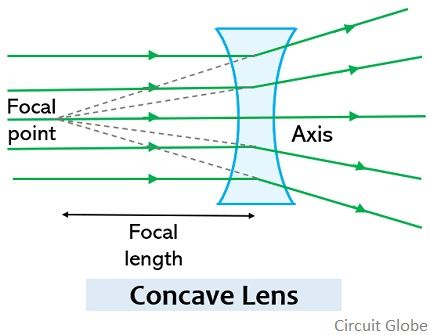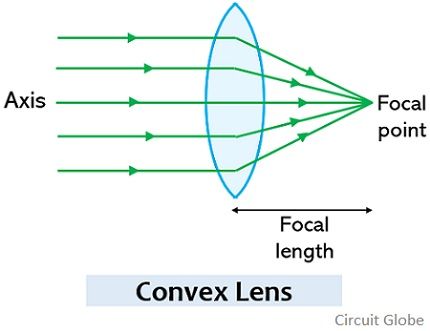Concave and Convex are two types of lenses that possess variation in physical shape as well as their properties. The crucial difference between concave and convex lens is that a concave lens diverges the light rays that incident on its surface. On the contrary, a convex lens has the ability to converge the light rays passing through it.
These two lenses display distinct properties and have different applications according to the shape of the lens. Let us first understand:
What is a Lens?
A lens is known as an optical instrument that either converges or diverges the light beam that incidents on its surface by using the principle of refraction. It is actually a piece of glass in an appropriate shape which is responsible for converging or diverging the light rays. It is moulded in a way to refract the light rays in order to form an image.
The power of the lens is defined in terms of a measure of convergence or divergence, the lens introduces to the light rays that incident on it. Here we will see how a concave lens is different from a convex.
Content: Concave Lens Vs Convex Lens
Comparison Chart
| Basis for Comparison | Concave Lens | Convex Lens |
|---|---|---|
| As known | Diverging lens | Converging lens |
| Shape of the optical surface | In concave lens, the centre of the glass piece is thin while the edges are thick. | In convex lens, the centre of the glass piece is thick whereas the edges are thin. |
| Polarity of focal length | Negative, thus sometimes referred as negative lens. | Positive, hence another name used for it is positive lens. |
| Behaviour | It diverges the light rays. | It converges the light rays. |
| Presence of focal point | On the side of lens from where the rays are falling. | On the opposite side of the lens from where the rays are falling. |
| Type of image formed | Always forms virtual and erect image. | Generally, forms real and inverted image. |
| Vision defect | It is used to correct Myopia | It is used for the correction of hypermetropia. |
| View | Farther and smaller than the actual entity. | Nearer and larger than the original entity. |
| Example | Lens in human eye, microscope, telescope, etc. | Flash lights of vehicles, lasers and peepholes of doors. |
Definition of Concave lens
A concave lens is a type of optical lens where the surface of the glass is curved in an inward direction making the center thinner than the edges. Its outer surface somewhat resembles a cave.
When a light ray falls on the surface of the lens then it bends the light rays passing parallel to its principal axis. Basically, the curvature of the lens is responsible for the direction in which the ray bents, the amount with which it bents, and the material of formation. In a concave lens, the center is quite thinner than the edges thus the curve is present in an inward direction. So, when the light rays pass through it then despite bending towards a single point, it disperses.
Thus, concave lenses are diverging in nature.
In the concave lens, the path of the rays is traversed behind the lens so as to get the focal point. As the rays diverge in the case of concave lenses thus, their focal length is negative.
Definition of Convex lens
A type of optical lens whose surface is bulged in an outward direction making the center thicker than the edges.
We have already discussed that when light from an object incident on the surface of the lens then it gets bent. Also, the direction of bending depends on the curvature and material. So, as in the case of the convex lens as the center is thicker than the edges thus the ray of light passing through it gets bent in an inward direction towards a single point. Thereby giving rise to the convergence of light rays hence, called a converging lens.
The single point towards which the rays bent is the focal point thus in the case of convex lenses, the focal point is present on the opposite side of the region from where the rays are falling. Thus, its focal length is positive.
Key Differences Between Concave and Convex lens
- The key factor of differentiation between a concave and a convex lens is that a concave lens diverges the light rays that travel parallel to its principal axis. As against a convex lens, converges the light rays that incident on it along the direction of its principal axis.
- Due to the nature of the lens, the incident light rays either converges or diverges after passing through it. Thus, the concave lens is also known as a diverging lens while the convex lens is known as a converging lens.
- These two lenses are also differentiated on the basis of shape possessed by them. A concave lens exhibits a cave-like structure from the outside as it has a thinner middle portion and thick edges. However, in the convex lens, the edges are comparatively thinner than the center of the lens.
- The polarity of the focal length is negative in the case of the concave lens while it is positive for a convex lens. Due to this the diverging lens sometimes referred as a negative lens while the converging one is referred as a positive lens.
- The image from a concave lens is always virtual and erect. While the real and inverted image is formed from a convex lens. However, in case the object is very near to the lens then the resultant image is virtual, erect, and magnified.
- Lenses are used for the correction of issues related to vision. The concave lenses are used to cure myopia while the convex lens corrects hypermetropia.
- Convex lenses hold magnifying abilities thus are generally used in the lens of microscope and telescope, also, the human eye lens is concave in nature. But, a convex lens is used in lasers, flashlights of vehicles as well as peepholes of doors.
- In the case of a concave lens, the body or object near it appears to be present at distant and is smaller than the actual one. However, when a body is present in front of a convex lens then it appears in a way that it is present nearer and is of larger dimensions than the original body.
Conclusion
Thus, the above discussion between a concave and a convex lens concludes that both have different physical shapes and generates a different form of images when light rays incident on it thus have different applications.



Thanks for helping
It is very helpful.Thanku
Thank you very helpful